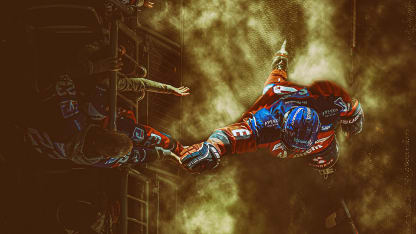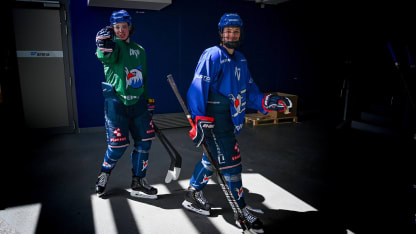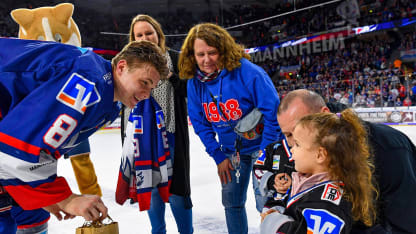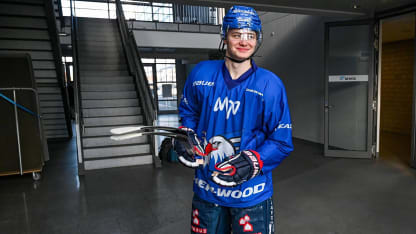The 2020 NHL Draft will be held virtually Oct. 6-7. The first round will be Oct. 6 (7 p.m. ET; NBCSN, SN, TVAS). Rounds 2-7 are Oct. 7 (11:30 a.m. ET; NHLN, SN1). NHL.com is counting down to the draft with in-depth profiles on top prospects and other features. Today, a look at Tim Stuetzle and the development of hockey in Germany. NHL.com's full draft coverage can be found here.
2020 NHL Draft prospects signal new era in hockey for Germany
Stuetzle among potential first-round picks showcasing country's commitment to player development

Tim Stuetzle could become the highest-selected NHL Draft pick born and trained in Germany in the same year Leon Draisaitl became the first Germany-born player to lead the NHL in points. And that possibility is perhaps the strongest evidence yet that German hockey is on the rise.
Stuetzle and other prospects for the 2020 NHL Draft on Oct. 6-7 are the latest exceptionally skilled hockey players to be coming out of the country, six years after an overhaul to its development model instituted by the German Hockey Association (GHA).
NHL scouts and general managers have taken notice.
"It's excellent to see," Dallas Stars director of amateur scouting Joe McDonnell said. "For us scouts, a lot of times when you go into Europe, you're strictly looking at a Sweden, Finland-type trip and now we add another country to the list, so hopefully they can keep producing.
"This year's crop is excellent because you could have three first-rounders from Germany. Anytime you can grow the game, in any country, it's awesome, and this year had been exceptional for Germany."
Goran Stubb, the NHL director of European scouting, said he is glad to see hockey gaining traction in Germany.
"A young talented kid in Germany plays soccer, and if he doesn't play soccer, he plays handball, and then comes hockey," Stubb said. "But hockey seems to be on the rise in Germany. Their senior team went to the final in the [2018 PyeongChang Olympics] and was close to beating the Olympic Athletes from Russia (a 4-3 overtime loss in the gold medal game).
"Now we have a junior level. Dominik Bokk was drafted in the first round in 2018 (No. 25 by the St. Louis Blues) and last year it was [Moritz] Seider (No. 6 by the Detroit Red Wings). Now comes Stuetzle, [John-Jason] Peterka and [Lukas] Reichel ... three guys who I think could be first-rounders."
Stuetzle (6-foot-1, 187 pounds), a left wing playing for Adler Mannheim of Deutsche Eishockey Liga, Germany's top professional men's league, is No. 1 in NHL Central Scouting's final ranking of International skaters eligible for the 2020 draft, which will be held virtually.
It's the highest ranking given by Central Scouting on its international list to a player born and trained in Germany, and experts say he could be chosen as high as No. 2. Alexis Lafreniere, a left wing from Rimouski of the Quebec Major Junior Hockey League, is widely projected to be the No. 1 pick.
"Stuetzle is definitely the best German forward prospect since Draisaitl," said Thomas Roost, a regional scout in Switzerland and Germany for NHL Central Scouting, "and to be honest, Stuetzle is by far the faster, quicker, more mobile and more stylish skater than Draisaitl at the same age. Stuetzle creates 'oohs' and 'ahs' in the stands."
Draisaitl, who was No. 4 on NHL Central Scouting's final list of North American skaters in 2014 because he played for Prince Albert of the Western Hockey League that season, was chosen No. 3 by the Edmonton Oilers in the 2014 NHL Draft.
"My goal is to be drafted as high as possible," Stuetzle said. "My goal is to get chosen under the first three picks."
German gems
The NHL Draft has been held 57 times, with five players born and trained in Germany having been selected in the first round, but never more than one in any year: forwards Draisaitl, Marco Sturm (No. 21, San Jose Sharks, 1996), Marcel Goc (No. 20, Sharks, 2001) and Bokk, and defenseman Seider. Forward Dany Heatley, the No. 1 pick by the Atlanta Thrashers in the 2000 NHL Draft, was born in Germany but moved to Canada at a young age.
Scouts expect there could be as many as three among the top 31 picks in the 2020 draft.

In addition to Stuetzle, Peterka, a right wing for EHC Munich (DEL), and left wing Reichel of Eisbaren Berlin (DEL) are also on the scouting radar. Peterka is No. 7 in NHL Central Scouting's final ranking of International skaters; Reichel is No. 11.
All three represented Germany at the 2020 IIHF World Junior Championship.
Draisaitl won the Art Ross Trophy this season, leading the NHL with 110 points (43 goals, 67 assists). He's also a finalist for the Hart Trophy, awarded to the most valuable player.
NHL Draft Class: Mannheim forward Tim Stuetzle on what he enjoys most about hockey and his chances of playing in the NHL next season -
— Mike Morreale (@mikemorrealeNHL) July 2, 2020
Apple Podcasts: https://t.co/f3ZzPF9ir1
Spotify: https://t.co/xsdKCaSmCv pic.twitter.com/W5G6Ha1xVu
Of defensemen born and trained in Germany, Seider became the highest selected when the Red Wings chose him No. 6 in the 2019 draft. He was NHL Central Scouting's highest-ranking such player (No. 6 in 2019) on its International list prior to Stuetzle.
"Young guys aren't just benchwarmers anymore (in the DEL), they're actually part of the team and earning the coach's trust," Seider said. "A few rule changes have also helped out those younger German players who happen to be draft eligible."
A change in philosophy in Germany's development model and within the DEL has helped foster the growth of more young local players and sparked the turnaround of hockey in the country.
Changing of the guard
The overhaul to the development model instituted by the GHA in 2014 went a long way in helping teenage players realize their full potential.

GHA president and IIHF council member Franz Reindl said he felt radical changes were necessary after Germany failed to qualify for the 2014 Sochi Olympics and dropped to No. 13 in the IIHF world rankings.
"Youth work and what the clubs are doing with their junior teams was essential for young players to grow," said Germany-born goalie Philipp Grubauer of the Colorado Avalanche, who was selected by the Washington Capitals in the fourth round (No. 112) of the 2010 NHL Draft. "I can't tell a detail [as to] what makes a guy become an NHL player. It was a team effort."
Reindl helped institute a long-term sports concept called Powerplay 26 to help change the hockey landscape in Germany for the better.
"We introduced a completely new development system, changed competition rules and league structures in youth hockey, and we changed our coaching education system," GHA manager Michael Pfuhl said. "We really had to make some fundamental changes."
The changes were made with three primary goals:
1. Short term: Concentration on sports activities and an increase in grassroots programs to allow more young players on the ice while increasing efficiency within the youth development levels.
2. Midterm: Rebuilding of the federation structure and financial consolidation by taking a lead role in the German sports system.
3. Long term: Realizing the opportunity to win medals in the 2026 Milano Cortina Olympics and 2030 Olympics.
To achieve these goals, the association realigned its coaching education program to focus more on player development than on wins and losses.
The DEL also introduced an under-23 rule prior to the 2019-20 season that enabled each of the 14 clubs to add two skaters per game (19 total) so long as those players are under the age of 23 prior to Dec. 31. The two players must be eligible to play for the German national team, meaning they had to be Germany-trained skaters and not imports.
"The rule provides extra spots for young German-trained players on the DEL rosters and therefore is helpful for the development of younger players, such as Seider, Stuetzle, Peterka and Reichel," Pfuhl said.
The adjustment was made to ensure young Germany-born players were given a chance to showcase their ability in their own country and continue to develop in the country's top division.
"I know the country has been working on ways to get more young players in their league instead of older guys from other countries taking up lots of ice time, and that looks like it's paying off this and last season, for sure," Red Wings director of European scouting Hakan Andersson said. "I think if young hockey players see that there's a chance to play on the big senior team, that's a big boost for many of them and could maybe even be a boost to get more young hockey players starting in Germany."
A five-star system was also assigned to the Germany youth hockey programs. One star is awarded to a youth club team each time it fulfills certain criteria in each of the five difference categories, according to Pfuhl. The more stars a team earns, the more financial support it is given from a special development fund.

The categories include recruitment and learn-to-play, basic skills development, competitive hockey for under-16 teams, competitive hockey for under-20 teams, and hockey environment.
The new development model has given even more reason for young local players to grow and mature within the German leagues up through their draft-eligible season.
"German hockey has made big changes in the last couple of years and more young players are in our top league, which wasn't the case back in the day," Seider said. "We're already seeing the big achievements, winning the silver medal at the 2018 [PyeongChang] Olympics and the promotion of the Under-20 team to the [2020 World Junior Championship]."
Germany has improved its IIHF world hockey ranking each year since 2014 and is No. 7.
"We now have more skilled players thanks to the new programs," Pfuhl said. "We have more highly educated, full-time coaches working daily with the young talents. Guys like Uwe Krupp, Jochen Hecht, Marco Sturm and Leon Draisaitl are role models for more young players. They see the chance to make it into the NHL if they work hard. Though hockey is not the No. 1 sport in Germany, Leon is pretty popular because of his scoring records in the NHL."
Calgary Flames forward Tobias Rieder, who was born and trained in Germany before being selected by the Oilers in the fourth round (No. 114) of the 2011 NHL Draft, said, "There are so many people involved. It also helped when (current Los Angeles Kings assistant coach) Marco Sturm took over as national coach (in 2015). You could feel that it was getting better and running in the right direction. It's good to see that more and more players are coming over to North America and [making] it over here. It's all on the right track."
Stuetzle said having the opportunity to mature and develop in his country made all the difference in the world.
"Playing with men and training with men all the time was a big part of my life and they helped me out a lot," the 18-year-old said. "They wanted to make me better and I'm so thankful to my teammates. I was able to learn a lot from the veterans; it was a great season for me."
Bokk said giving young Germany-born players an opportunity to compete in the DEL makes a huge difference.
"If you're young and you play on the pro team and you're playing against men, that's probably the best that can happen for you," said the 20-year-old forward prospect, now in the Carolina Hurricanes organization. "It's pro hockey. It's a different world than playing junior hockey in Germany. I didn't get that chance and went to Sweden, played a couple of months and then got an opportunity to play on the pro team there. That helped so much as a player.
"Germany right now is doing a great job playing their young guys and we have a lot of great young players who can play in the DEL, and I think that's what makes German hockey much better."
The Mannheim machine
Jan-Axel Alavaara became general manager of Adler Mannheim in 2017-18. Mannheim won a DEL championship with Seider last season and had a 34-12-6 record with Stuetzle before this season was canceled because of the coronavirus.
Alavaara was an amateur scout with the Buffalo Sabres (2016-18) for two seasons before getting his opportunity with Mannheim, so he knows the caliber of player NHL clubs crave.
"Seider opened up the doors last season, for sure," Alavaara said. "Now, it's Stuetzle and the other guys showing that they're able to play, and people in this country want to see the young kids who play with a passion and a drive and who are not afraid to play hockey."
Mannheim coach Pavel Goss has been with the team the past two seasons. He told The Dispatch podcast that it wouldn't surprise him to see Stuetzle in the NHL within two years.
"I think his hockey IQ and his quickness are impressive," Goss said. "How quick he can beat the defensemen, accelerate and create the chances for his teammates. He can improve his quick shot, but he's only 18 and there's a lot of potential in Tim. He's going to be a great player."

Seider was named rookie of the year in the DEL in 2018-19 despite being limited to 29 games because of a shoulder injury. He had five assists in 14 playoff games to help Mannheim win the DEL championship.
"For a lot of young players like myself, Seider was the go-to guy," Stuetzle said. "He showed everybody that you can develop a lot even if you stay in Germany."
Seider had six assists in seven games for Germany in the 2020 World Junior Championship and didn't look out of place his first season in North America with Grand Rapids of the American Hockey League, scoring 22 points (two goals, 20 assists) in 49 games.
"I was really high on [Seider] prior to the 2019 draft," Andersson said. "I liked his hands, skating, poise and size, but a big thing also was his personality. He's a human being that is above your average player ... he's caring, outgoing and confident."
Stuetzle was named rookie of the year in the DEL this season after scoring 34 points (seven goals, 27 assists) in 41 games. He also finished second in scoring among players 18 or younger with five points (two goals, three assists) in eight games for Mannheim in the Champions Hockey League, a 32-team European hockey tournament that ended in February.
"The way our organization operates, it's almost similar to if you saw how Sweden or Finland build their teams," Alavaara said. "We have a full staff that includes skill coaches, off-ice coaches, performance coaches. They all take care of these young kids, work with them on a daily basis from video to mental toughness.
"I think Germany was behind everyone else maybe five to 10 years ago, but there are a lot of Canadians, Swedes, Finns, Czechs, and coaches from other countries outside Germany now working in the DEL, so we're making all the right steps."
Alavaara said the GHA has taken a little bit from every country in helping shape and develop the young players back home.
"I think coaches and managers are starting to talk way more with each other to help each other, too," Alavaara said. "To me, it seemed the teams were smaller and on their own island before, but that's not the case anymore. Everyone is working together to make sure our players have everything available to them."

The next one: Stuetzle
Stuetzle is quick to deflect any comparisons to Draisaitl.
"I think it's great to hear the comparisons**

















